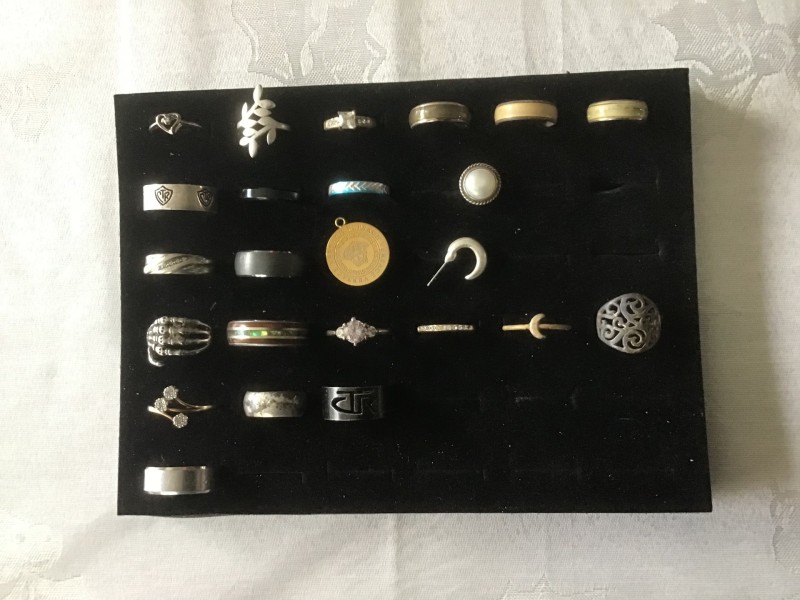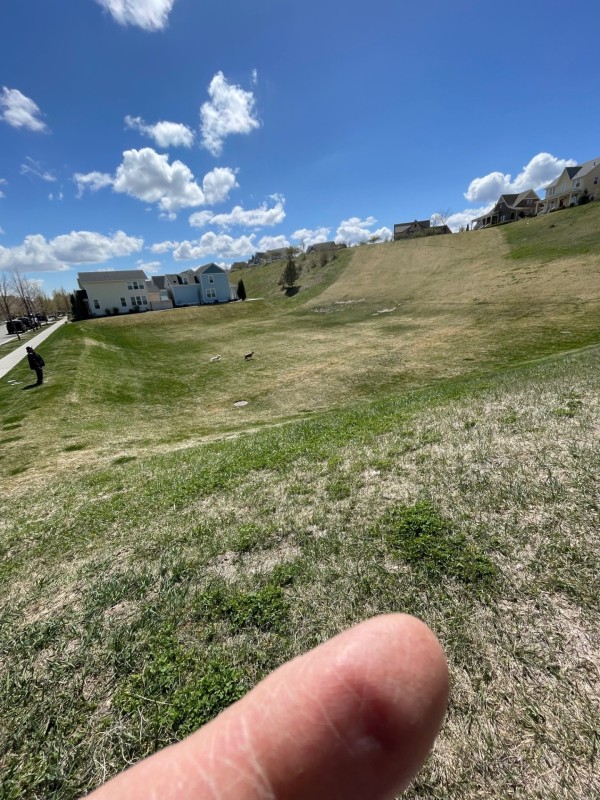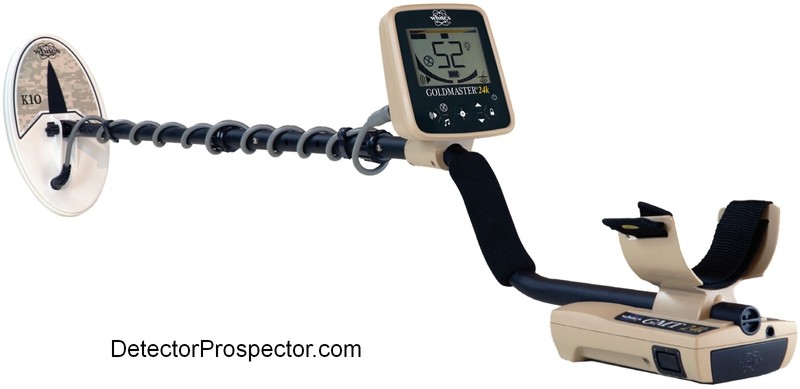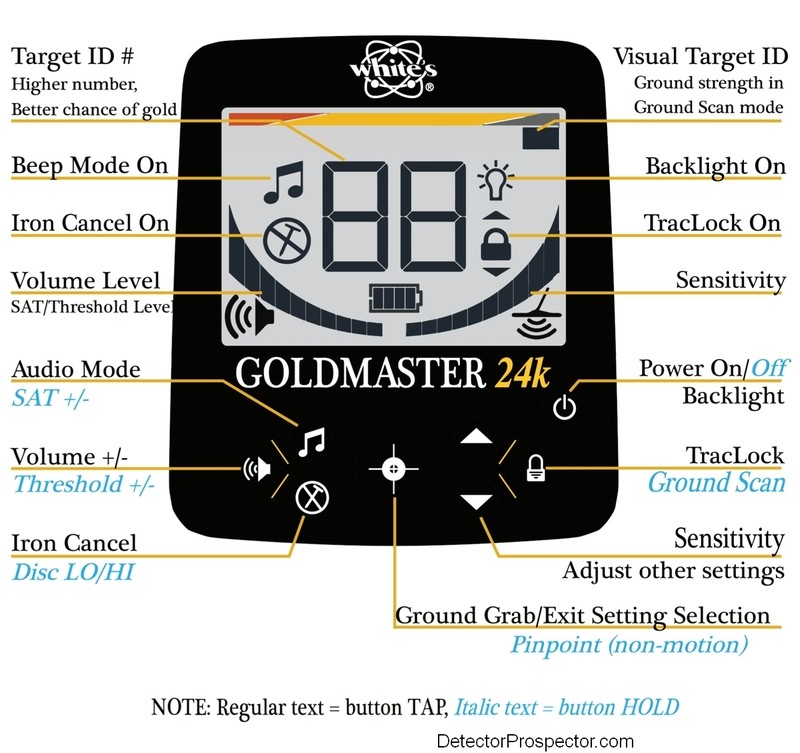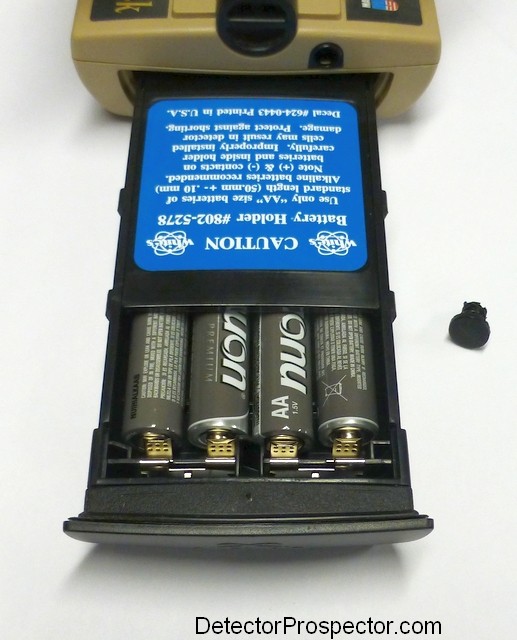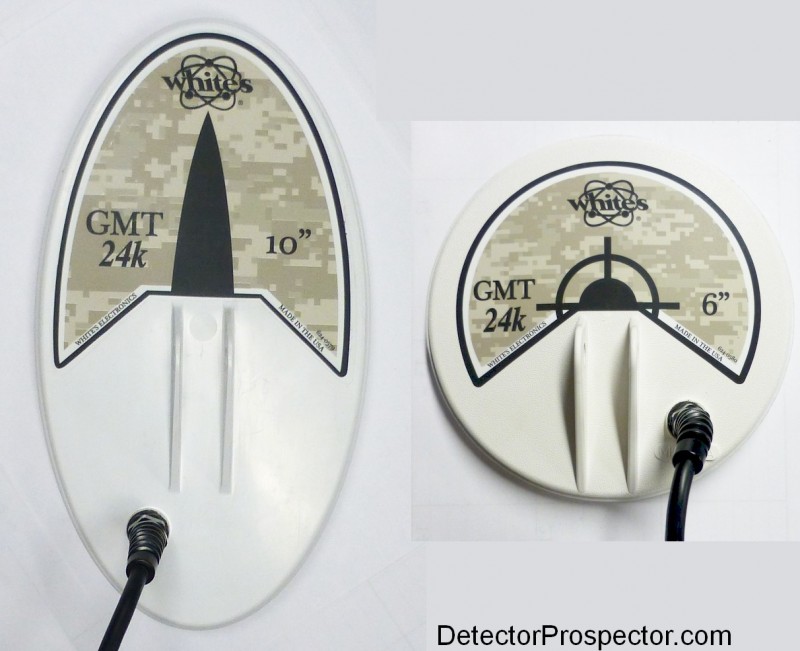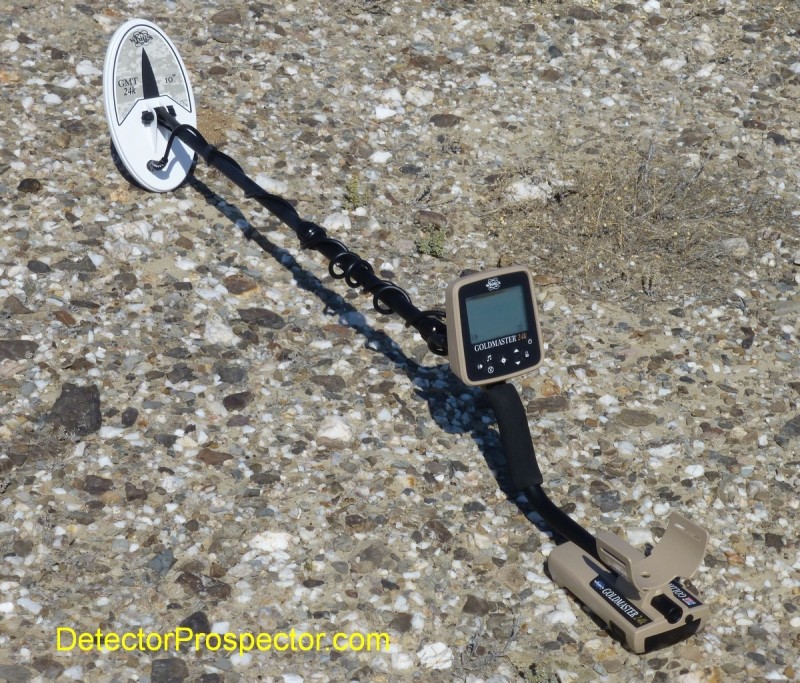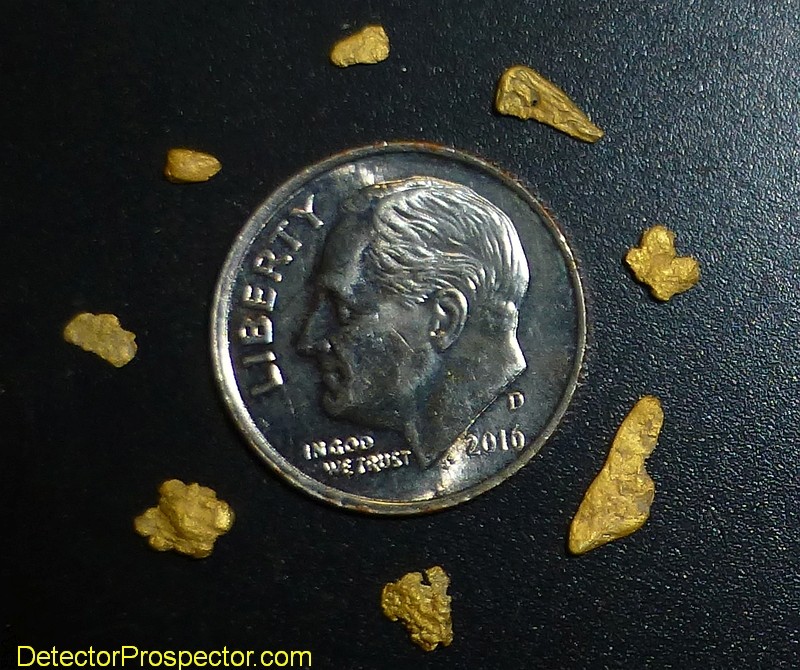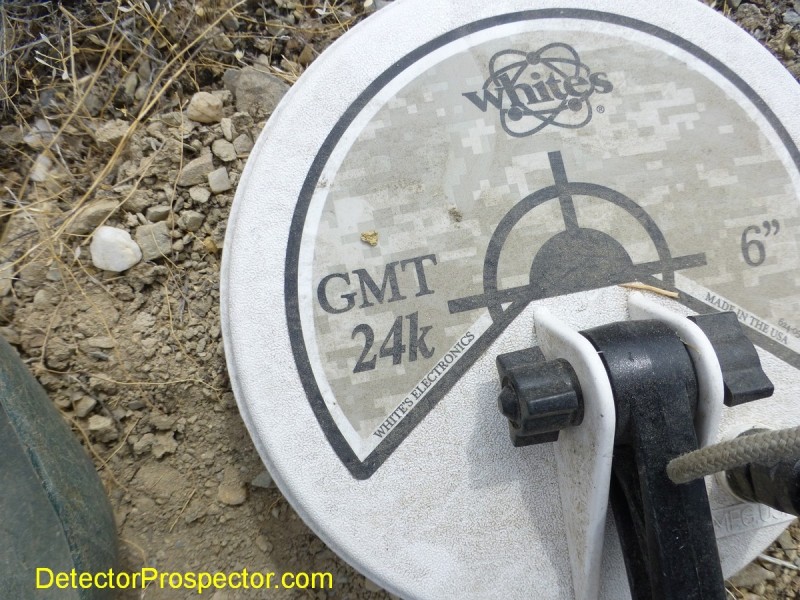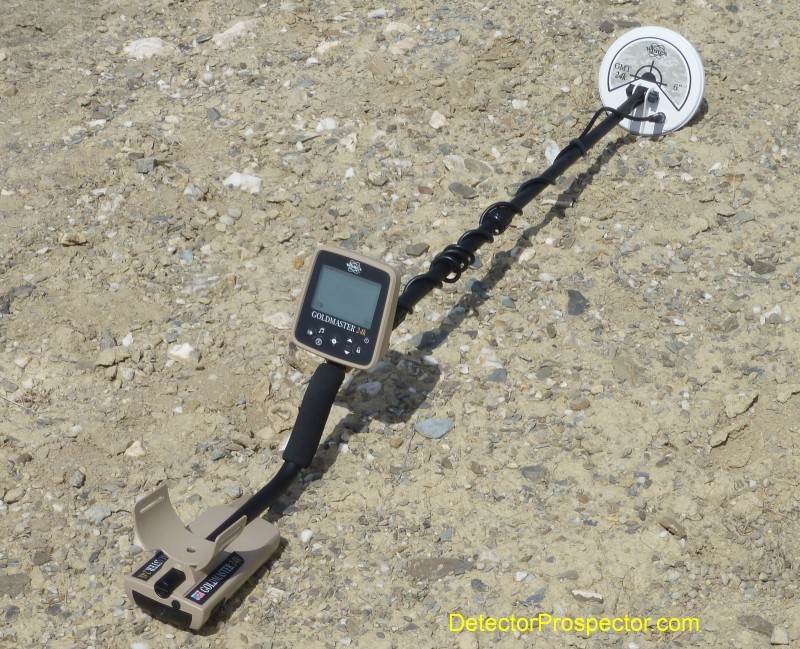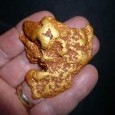Leaderboard
Popular Content
Showing content with the highest reputation on 04/20/2024 in all areas
-
I recently obtained permission for my club to hunt a sizable piece of property with historical group usage going back over 100 years. Over 40 of us showed up on the designated day. I heard several people say their first signal of the day was a silver dime! By the afternoon, I was getting a little discouraged with a wheat or two, some bullets, a fishing weight and a couple modern coins. I had also found a 12 pound section of an old brass pot or urn. Based on the radius of curvature, that thing must have been huge, not to mention extremely heavy! I had to make a special trip back to the car for that thing, as it was too heavy to carry with me all day. I finally broke the silver drought with a 64 Rosie after lunch. A while after that, another club member hunting near me found a beautiful Ben Franklin silver half. I told him it was gorgeous, and mentioned I had never found a half outside a seeded hunt - let alone a silver one. He encouraged me and said I will find one sooner or later and it might be a Walker or even a Barber. As he moved on, I hit a nail patch and decided to slow down and go over it. I was using my Deus 2 with the 11x13 coil - not optimum for dense nails, but I wasn’t going back to the car for the 9” that late in the day. After a little comparison, I switched to the Tekkna program. From what I have read, it might not be the best program for a large coil and dense ferrous targets, but it was more stable and much quieter in the dense nails than my custom program. After walking two lines through the nails, I had recovered four wheats and a worn cuff link (?), and figured there may be more hiding. Sure enough, I hit a nice mid-90’s signal that was so strong it had to be a can lid or the like. But, with multiple nearby wheats, I was digging it anyway. About three inches down, I caught my breath as I saw a silver disk emerge. Surely, it was an aluminum punch like another one I had found, but then I saw the reeding on the edge. I was flabbergasted to see Lady Liberty emerge from the dirt! Despite the dense iron (based on the stain, it would appear the coin was actually in contact with iron) using Tekkna and the 11x13 worked well. I would say this is the best coin I have ever found! In hindsight, I wonder what would have happened if my club member had said I would find a $20 gold piece…🤪 I also found a maple tree tap and what I think is a musket ball. The wheats range from 1911 through the 1950’s, with only the 1920’s not represented. We are working on permission to go back again!7 points
-
7 points
-
Flat Spiral Wound Coils increase and concentrate the magnetic field near to the coil. The following four ten inch coils are designed with 2 mm Litz wire with number of turns needed to approximately meet the industry standard inductance of 300 microhenrys (uH). The flat spiral coil has 43 turns in a 3.39” band that leaves a 3.23” diameter center hole. There is another flat spiral coil that has 0.1 mm spacing between turns. It has 55 turns that leaves a 1” diameter center hole. The 5x5 stacked coil has 24 turns in a 0.4” square band that leaves a 9.2” diameter center hole. The cylinder coil has 16.5 vertical stacked turns in a 0.2” band that leaves a 9.8” diameter center hole. The magnetic unit of Tesla or milliteslas (mT) is named after Nikola Tesla. Examples are (5 mT) – the strength of a typical refrigerator magnet; (.05 mT) – the strength of the earth’s magnetic field on a compass. The attached chart shows that the magnetic field of spiral wound coils is strongest close to the coil and concentrates through the center hole of the flat windings. This provides exceptional results on small nuggets and sharp pinpointing within the center hole of the coil windings. Click on chart to expand it.6 points
-
I budgeted for a new Detector this year and was waiting to see what the Garrett Storm might be all about. With $500 off and a 15% Veteran discount I jumped on a new Manticore today. I then got to wondering if Minelab has made a "pre-emptive" strike against Garrett and the upcoming Storm with offering the Manticore at such a great price. Time will tell I guess. In the meantime I now have one Detector for each day of the week 🙂 Sure glad the wife enjoys detecting as much as I do.6 points
-
I'm finally going to spend a day on this permission tomorrow. It will be my first time out in a known gold bearing area. I'm really looking forward to it. I'm heading there with high hopes, and will probably leave with a big dose of reality. Either way, my wife and I will have a great time. I'll update with any good finds.5 points
-
I don't see why anyone would think prospectors don't need ferrous disc. A gold PI is typically going to be designed to hit the tiniest bits possible and that can also mean tiny ferrous bits. A relic PI might be more tuned to hit bullet size targets at max depth while being less sensitive to every tiny bit of ferrous trash. In theory though you can do both in one detector so interesting to see why they feel the need for two models. It could be nothing more than what coil the machine comes with. We have no idea what the detector really looks like but let's go with the fuzzy profile as being real. Standard configuration with collapsing three piece rod, fairly large underarm battery. Big question - it it submersible? Beach hunters will be disappointed once again if the answer is no.5 points
-
4 points
-
That one made of gold none of us will be able to afford It LOL sorry could not resist LOL4 points
-
Last monday I finally started the test phase with the Manticore and the M8 underwater. After a minimum of settings adaptation, I recovered three small and light pieces for a total amount of almost 6 grams in total. Tuesday underwater again and Wednesday wetsand workout, nothing to register...Until today on the wetsand...I was again with the M11 and after the usual coins and an unexpected sinker on the slope, minutes after a solid 17 screaming to dig it. It was a 4.45g 18k piece. What else can I say...Jeez...If there's something left, this is the most similar tool to a vacuum cleaner 😅4 points
-
I live on the property of a 1400 acre conference center that also has two summer camps for kids. Up on the mountain behind my house is a former camping area. There’s also an old spring up there where I’ve found old relics and two silver dimes. The camping area probably hasn’t been used in at least 20 years so there’s older stuff mixed in with newer stuff. I hiked up there Saturday afternoon determined to find something good. I’ve hit this area quite a few times, but I never really scoured the camping area that hard. I immediately stared hitting some modern clad and then I got a solid 57 using the Tekkna program. About two inches down was a 1.43 gram 10k ring! Soon after that I hit a shiny silvery looking ring (not silver😧), and then not long after that what looks like an old copper wedding band. Here’s some pics. The pic of the spring was taken back in 2022 when I discovered it.3 points
-
and the one made of relics sounds like a load of old junk.. 😁3 points
-
3 points
-
Finally! First we had Algoforce but now the real battle starts in pulse induction, with Nokta likely to set new price/performance ratios i.e. bang for the buck. "Join our naming competition and get a chance to win one of our future Pulse Induction machines! One designed for gold prospecting and another one for relic hunting! These detectors will redefine affordability and performance for you to break free from the grip of overpriced alternatives!" ENTER CONTEST Deadline April 30th3 points
-
The majority of machines I see on the Florida coast are the 800 followed by Excals. I run across one guy from time to time who uses the D2. Some Ace machines on the dry sand but most are snow birds. I was one of the lucky water hunters with my 800 that never flooded. I did break everything else on it, but all was covered under warranty. I was down to one detector and when the Manticore came out I grabbed one and it is my go-to machine all the time now especially since my 800 was long out of warranty. I used a friends D2 on two different occasions and didn't care much for the small, complicated screen. Also had the antennae wire pulled off after seaweed got the best of it.3 points
-
2 points
-
He was on the ground near the pool negative edge a little hummingbird fledgling, we planned on just keeping an eye on it so it’d be safe from pigeons and geckles until it fell in the pool. My daughter rescued the poor little thing luckily it seems to be hanging in there. crossing fingers it makes it through the night. We will put him back out tomorrow and hope mom shows up. We called a rescue place too hope they return our call in the morning. this is gunna be a long night I think, lol I put him in a Dixie picnic paper bowl nest and set it on my nightstand cause they gotta eat every 20 to 30 minutes sat down on the bed and he was hanging by one foot off the side of the nest bowl heading in my direction, ha guess this is how it’s gonna be tonight anyway. shucks, it was cold…2 points
-
Nokta Detectors The Legend - Version 1.14 Beta 2 Test - RELEASED! Updates Made: 1) When switching to Beast mode, All Metal discrimination pattern will be selected automatically. When switching from Beast mode back to Gold Field mode, the last selected discrimination pattern in Gold Field Mode will be restored. 2) Update in the Ground Balance Menu a) When selecting between FerroCheck (FC) and Mineralization Indicator (GI), the 'FC' or 'GI' indicators displayed on the right side of the screen have been moved to the left. b) The 'FC' or 'GI' indicators which remain on the screen until exiting the menu will be automatically cleared from the screen after 2 seconds. c) When the Tracking feature is activated, the ground balance level flashes on the screen. In Beast mode, when the Ground Balance 2 is activated while the tracking feature is on, the ground balance level will be shown steady to avoid confusion. 3) General improvements have been made.2 points
-
Well, they had a winning formula of suggestions on this forum, let's hope they didn't listen to Youtube and Facebook influencers too much and neglect the suggestions here unless they were in line with each other. I'm puzzled why they're doing two models other than for more sales as surely one detector could handle both jobs and give people even more bang for the buck. Hopefully it's just the supplied coil options although I have a very bad feeling they've gone down the path of their own coils not compatible with GPX coils and if its chipped like the Legend then there is another reason for its uptake to be slower than hoped. I guess their Relic one will have the Algoforce Target ID's and possibly DD coils and blanking, features that would also be good on a prospecting machine. They missed the beach part of the market, always neglected, I guess that's the Impulse's fault having trouble selling 100 detectors. Good to see they're indicating it will be cheaper, perhaps not than the Algo but than the Minelabs. Unfortunately, I have too many detectors, so having another gold machine in my cupboard is very unlikely unless it betters what I have, and that's unlikely but we can hope and dream!2 points
-
The Family has been located! I just got off a speaker phone conversation with Louis, and the family he has returned the medallion to - WOW! More to come..2 points
-
If it’s going to take a year to name it and another year are more for it to hit the market then you just as well call it a day late and a dollar short . That’s what it’s going to be if it takes them as long as it did with the Legend. You got two other companies if they wanted could have something at a lower price than what they have to offer now. Sometimes profit comes in volume of sales of items. That’s when you remold and repaint then sell it under a different name. We shall see. Chuck2 points
-
Knowing how Minelab will typically react, I say we call it...wait for it... THE NOKTA LITIGATOR No other detector can do it justice!2 points
-
First we had Algoforce but now the real battle starts in pulse induction, with Nokta likely to set new price/performance ratios i.e. bang for the buck. "Join our naming competition and get a chance to win one of our future Pulse Induction machines! One designed for gold prospecting and another one for relic hunting! These detectors will redefine affordability and performance for you to break free from the grip of overpriced alternatives!" ENTER CONTEST Deadline April 30th2 points
-
Progress, but lets not get too optimistic on the timeline. The last time we went through a Nokta naming contest, the Legend showed up 3 years later. Contest started September 2018 Name picked September 2020 Detector Announced Summer 2021 Detector Released December 2021 Perhaps they learned not to draw this out as much this time....2 points
-
I agree, the tech is definitely approaching it's ceiling, and I've been very happy with my EQ800 for the last 5.5 years. My main complaints involved build quality issues much more so than performance. To make a long story short, I needed to replace my 800 control pod two years ago, so I decided this year was the year to look at moving on to something different, while I could still get good resale on the machine with a year of warranty left. I looked at the EQ900, but it didn't seem to offer enough (if any) improvement for the cost, and I didn't like some of the reviews from other detectorists that I trust - a few of them were previous 800 owners, and several sold off their 900s or went back to the 800. The Manitcore was appealing but I couldn't justify the cost for the potentially minimal gain in performance. I decided to try a Legend starting in January - I wasn't expecting an increase in performance, just an increase in build quality and roughly equivalent performance, and at a much better price. That's essentially what I got for the investment, and the Legend works very well - though I'd make the case that it's performance isn't quite the same in some areas that are important to me, and I'm not convinced (after almost 100 hours) that it's the machine for me. Anyways, the price drop on the Manticore was enough to entice me - if it was at this price point in January, I would have bought it over the Legend without a second thought. Pulled the trigger last night. Once it arrives, I'll suddenly have three detectors when I've always just had one, and I'll suddenly have an irate wife! But if the Manticore provides better build and even marginal gains over the EQ800 as it seems to promise, then it'll be worth it to me - I'll finally part with the 800, and the Legend will likely get sold as well.2 points
-
Actually there was an anything goes sub-forum for years that finally got nuked as even Bill got fed up with it. That plus the “sooner or later” and “habitual offenders” is why I made the comment. Action here is immediate and more than once is a probable ban. I actually hate being a watchdog so the easiest solution is to get rid of those that need watching. I'm sorry, I'm not trying to be a jerk to new arrivals. I just don’t want anyone being caught unawares by my evil draconian oversight.2 points
-
Hi Mike, you are welcome... My iron technique has developed over the years from reading Charles Garrett's books in my early days. A simple fact is iron distorts the "electromagnetic field" generated by your searchcoil. In other words, when you approach a medium to large rusted iron target, your "field" reacts to the iron sooner than a non-ferrous target. If I get a single loud target, sometimes high pitched, that could sound like it is on the surface, I switch to a non-motion pinpoint mode (very slow or no auto-tuned) and pull the searchcoil away from the target area (no sound). Then I move slowly back towards the target without detuning the signal like you might if you were pinpointing it. As I start to hear the target audio, I keep my eye on the ground where this happened and notice how far the opposite side (trailing side) of the searchcoil passes beyond this ground spot. More simply put, if the target response is wider than my searchcoil's width, I can usually count on the target being iron based. If the target is non-ferrous, such as a coin, the signal will be less than or equal to the searchcoil's width. If the signal width is very wide, it can also indicate quite a large target of iron. Very important to not ignore overly loud signals. I have an 1850's NYS Militia Plate on my dresser to remind me of that! Yes, we have all found those deeply (intentionally) buried aluminum soda and beer cans too! Obviously multiple big iron targets near a smaller non-ferrous target is a little more difficult to use this iron technique on. If a little non-ferrous high pitch repeatable blip goes faint or disappears amongst iron as you raise up your searchcoil passes, I'd use my other technique... "When in doubt, dig first, complain later!" 🙂2 points
-
1 point
-
Nice pictures! Shows the serenity of the area. Those rings are all nice finds!1 point
-
Excellent hunt, Ghound. 👍 Looks like a campground to me, for hunting and other activities. I've dug those aluminum tent pins before. Is that a big brass bell shard? I think it was NCToad that suggested otherwise regarding using the 11x13 with Tekkna, and posted a video with a theory about it. He's had some pretty stellar results using the big coil as well. It's on this page: I've used Tekkna with all 3 coils, but trash situations vary, so it's great to think outside the box. One of the places I used it I did better with the 9", but that big coil seems to do very well. 🤔 When relic hunting I keep one or the other coil (9" or 13") in a light fly fishing backpack vest with pockets for other stuff like spare bolts 😅 Congrats on the Walker, that is one of the most beautiful US coins. Best of luck to you if you return to that place. 🍀1 point
-
Hey brother its all good just could not pass ribbing you on that one, feel free to pay me back LOL1 point
-
Thanks very much to all the members of this forum for the precious advice. Finally i chose the f75 LTD (i found one like new for 300€) because i had a very good feeling, some Years ago, with the T2. I Will use It when i don't want to spend too much time with the set-up, and when i want to relax. Maybe in the future i will try and buy the Legend, but now i still prefer use my Deus 2 ( ws6) and try to learn It well to unlock his full potential, with different programs like tekna. Thanks very much1 point
-
I just got permission to detect a large piece of land in a well known gold bearing area. It is private land that nobody has been prospecting for many many years. Everything around it is claimed up tight. It's hard to describe how excited I am about this permission. I will have miles, not acres to hunt. 😁😁😁1 point
-
1 point
-
1 point
-
1 point
-
1 point
-
A very happy lady with a nice recovery. It is always nice to enhance the hobby with good deeds.1 point
-
Palzynski and I are both former Ace Apex owners. We both had some legitimate problems with our purchases that had to be addressed by Garrett. I really like the Ace Apex. It is one detector that I miss owning because of its excellent display and controls layout. That display and controls layout are one reason that I really like my Garrett Axiom. Another reason is that my Axiom works really well at all of the sites that I have used it. I just can't say that for the Apex. There are many detectors that simply don't fit the ground conditions that I most often hunt in and the Apex is one of them. The same goes for the Minelab Vanquish models and even the Equinox 700, 900, CTX 3030, Etrac and the earlier White's SMF detectors along with every single frequency VLF that I have ever owned. So all of this is just to say that sometimes its the operator, sometimes its the detector, sometimes its the quality of the location but all of the time, ground conditions rule over all three and the detector I'm using has to be able to first and foremost handle the ground conditions.1 point
-
After owning and loving 5 Equinox 600/800s, I thought I just couldn't survive without one. Now I own the Legend and Manticore. I simply do not miss my Equinox 600/800s at all. I don't even think about buying another Equinox or have the slightest bit of seller's remorse. The Legend and Manticore easily out perform the Equinox 600/800 where I detect the most and I don't have to worry about leaking and build quality either.1 point
-
I used to do land boundary survey work and had to go to the county surveyor to look up the most recent plat maps. These maps usually got us in the right places to start looking. Note: On ground markers our what are legally binding unless tampered with. Don’t count on ONX maps or county google map locations as they can be off a little bit or in some cases I have found them off by a 1/4 mile. Caltopo map is a good source for looking the area over for mining areas and then seeing the nad 27 topo overlays.1 point
-
You've gotten quite a bit of good advice answering your specific questions. But since this forum is more than simply about specific questions or those who ask them, I'm going to throw a curve ball. Most of us have limited time to detect -- i.e. we wish we had more. Learning how to set up and use detectors is a necessary part of the endeavor. But adding a new detector and its learning process takes time away from learning about the one already in possession. In your specific case you seem to be a bit frustrated (at times, anyway) with the complexity of the Deus 2. I don't have one of those so can't comment specifically, but in my experience with other detectors, the better I get to know a detector the less complex it becomes.1 point
-
1 point
-
1 point
-
It was once 🫢. In 2007 Me and my dive buddy were searching for gold and it was appearing almost everywhere. Today We don't even search together the same area as a form of respect, due to the lower concentration of finds. What I post here is like 10% of what I've seen in 2 decades💀1 point
-
Hi Dennis, Age is catching up with us both! Hard call as the Gold Bug 2 is still an excellent machine and you are familiar with it. I myself am going to the Manticore with 5x8 coil for general detecting and that will also include nugget detecting. I am getting to where just one general purpose detector will suit me fine as long as it is also decent for nugget detecting, and Manticore does well in that area, while also serving me for other uses. I'd still bet on the Gold Bug 2 for the tiny bits. Only real reason to consider the Manticore is if you are interested in it's other capabilities i.e. coins, jewelry, relics, beach. If you do think you want a Manticore now is the time, as it is $500 off until May 6th. Good videos here in Nevada. Having seen it in person I was impressed and next time out in the desert I'll be swinging the Manticore.1 point
-
I don’t post much, but I thought this might be interesting. The weather has been beautiful the past week, so I hit up an elementary school and a snow sledding hill across town and found a total of 21 rings including three gold, three .925 and fifteen junkers. As pictured. On Saturday the school gave up six rings, including a 2.3 gram 10k, one .925, and four junkers. Someone had cleaned out most of the high tones, but left the copper pennies. That’s where the silver leaf ring was, in the Pennie’s. The top row is from the school Sunday I scouted a small snow sledding hill nicknamed “suicide hill.” Lots of injuries from stupid behavior, like six kids crashing a kayak on the hill resulting in a broken leg. Duh. During the summer kids ride 20 pound blocks of ice down the hill. Sounds like some of the stuff we did growing up in the 50s! Anyway, I hunted the hill and little quarter acre park on top Monday thru Friday and did really well. I don’t believe it had ever been hunted. Rows two thru six are the rings found each day. Monday brought a silver ctr ring and a broken silver earring. Tuesday gave up a 6.25 gram 10k white gold men’s ring and a Versace medallion. Wednesday was all junk. Thursday gave up the 2.8 gram 10k with the brilliant stone flowers, a .925. And by Friday, I finished gridding the hill itself and called it quits with one last junker. i still need to have a jeweler look at the flower stone ring before my wife claims it. Clad count for the five days was $49.30. Wednesday produced $15 in quarters from the apex of the hill along with the six junk rings. This was an unusual week. With clad counts dwindling, I have been focusing more on mid-tones and lower in my daily 2 1/2 hour hunts. I’m at 60+ rings for the year (4 gold, 12 silver), but only $150 in clad. I feel like I’m digging fossil coins. Good sites are rare but still out there. Happy Hunting to you. ”J”1 point
-
The White's Goldmaster 24K is a new 48 kHz gold nugget detector released in the fall of 2018. Production models started shipping in September and White's forwarded one to me to check out. What follows are my thoughts after a couple days of detecting for gold on several northern Nevada nugget patches. The Goldmaster 24K marks a break with the past as White's moves from the older metal box designs of the past to newer plastic cases. The Goldmaster 24K physical design is the latest in the evolution of the MX series. The control box itself is derived directly from that used on the White's MX5. The control pod / display originated with the TreasurePro and later used in the MX Sport and MX7 designs. Basically the Goldmaster 24K is in the same housing and rod design as the White's MX7. Manufacturers face a difficult design choice these days. In general users want metal detectors to be as light as possible. However, weight is not everything - balance matters every bit as much. The problem is that a metal detector search coil is basically a weight on the end of a long stick. Coils can only be made so light due to engineering constraints requiring a certain amount of copper wire, and a reasonably robust coil housing. The coil therefore has a lot to do with determining the final ergonomics of the detector. If the coil weight is not balanced at the other end with some kind of offsetting weight, the detector is nose heavy. This in turn creates torque everytime the detector changes directions, which puts stress on the operators arm. The detector can be made as light as possible, or can be perfectly balanced, but it is almost impossible to do both in one detector. Any detector that weighs less than 3 pounds is almost certain to be nose heavy because enough weight does not exist to balance the weight of the coil. In order to have enough weight to work with it appears the minimum is about 3.5 lbs for detectors that are well balanced. The extra weight is almost always in the form of a battery box located under the elbow. White's has gone this route is the MX series designs with a battery box holding 8 AA batteries under the elbow acting as a balancing weight. This results not only in a well balanced detector but a detector with enough batteries to operate for multiple days between charges or battery changes. White's Goldmaster 24K metal detector for gold prospecting Another big choice manufacturers have to make these days is whether to use a straight rod or a "S" rod design. Users tend to be evenly split as to which they prefer, and so this is a choice the manufacturer cannot possibly win. About half the people are going to be unhappy whichever way you go. Industrial type users like beach hunters and prospectors tends to prefer straight rods. Coin, jewelry, and relic hunters seem more inclined to "S" rods. I have used many detectors with either setup, and have been happy with both or unhappy with both. The deciding factor for me has been more about the exact size, shape, and angle of the hand grip than the actual rod design. I do not have over-sized hands, and so I tend to prefer a smaller diameter grip. Other people like a larger grip. I went into all that detail to be sure the reader understands that weight and balance is very much a personal preference item. Getting a detector to fit right for everyone is like making a pair of boots that fits everyone. You can't do it. Therefore when I say that the MX physical design as employed in the Goldmaster 24K is a very good fit for me don't take that as meaning it will be great for you. Yet it is a very good fit for me, and quite comfortable on my arm, with just enough forward weight to keep my elbow in the arm cup without having to use the arm strap. The design is also lighter than the White's GMT by nearly half a pound, so the Goldmaster 24K is both well balanced and lighter than what came before. The Goldmaster 24K with 10" elliptical coil and with batteries installed weighs 3 lbs 7 oz (3.4 lbs) or 1562 grams on my digital postal scale. The Goldmaster 24K has an IP54 rated enclosure that has a high level of protection against dust particles, and a fair amount of protection against water. The coils are waterproof, but the detector itself is not submersible, so keep that display pod out of the water. The "S" rod is a three piece design with excellent quality twist locks that create a firm, wobble free rod assembly when fully engaged. The armrest position is not adjustable but it is well placed. The 24K is powered by eight AA batteries in a battery holder that pops out of the rear of the battery box. The 24K is supplied with eight alkaline AA batteries, but rechargeable batteries may be substituted for use in the battery holder. The 24K can get up to 40 hours operation using high quality alkaline batteries and while using headphones (external speakers use more power). The Goldmaster 24K does have a speaker built into the rear of the display pod, and there is a female 1/4" headphone jack directly above the battery door. White's thoughtfully includes a small plastic plug to insert into this hole when not in use. White's 24K battery holder and headphone jack location The Goldmaster 24K comes with a 5.5" x 10" DD coil as the stock coil. A 6.5" round concentric coil is available as an option. Scuff covers for the coil are not included with the detector or when you buy an accessory coil - they are separate optional items. The 5.5" x 10" DD search coil weighs 14.5 oz or 412 grams. The coil is 1" thick. The 6.5" round concentric coil is 3/4" thick and weighs 13.1 oz or 370 grams. Therefore the 24K when outfitted with the 6" concentric weighs in at 3 lbs 5 oz (3.3 lbs). White's possibly has a 13.5" x 8" DD available soon that weighs 1 lb 8 oz or 682 grams. Finally, a version of the 4" x 6" Shooter DD is in the works also. Neither of these coils is available for sale as of March 2019 (edit - they are now), so for now the GMK has one accessory coil (the 6" concentric) available for purchase. Do note that all pre-existing coils for other White's Goldmaster or GMT models are not compatible with the Goldmaster 24K. The 24K pumps about 50% more voltage to the coils than previous models, requiring tighter tolerances in the new coils. The coil connector has been changed to prevent confusion. 5.5" x 10" DD search coil and 6.5" round concentric coil for White's Goldmaster 24K The Goldmaster 24K shares many functions with the White's GMT model but there are differences. The most obvious being that the GMT uses knobs for control adjustments. The 24K uses a sealed touchpad which is more water and dust resistant, but some controls have secondary functions that necessitate having the Quick Guide near at hand when learning the detector. The 24K like the GMT does of course have a sensitivity control, and like on all hot VLF detectors it is a critical control. The solution to most problems regarding metal detector instability, or interference, is to reduce the sensitivity. The 24K features both automatic ground tracking, or a fixed ground balance, adjusted via a tap of a "ground grab" button. In this case the pinpoint button doubles as a ground grab when given a quick tap. Ground tracking can be a great function for variable ground and people new to detecting. Personally I prefer to lock the ground setting (via the "Lock" button) and update it manually via the ground grab function. I did use the ground tracking however, just to try it out. It is lightning quick, taking just a pump or two to track into the ground. Ground grabs are instantaneous. The White's GMT allowed for a locked ground balance to be tweaked up or down manually, via plus or minus buttons on the control pod. The 24K takes a slightly different route by allowing a "ground balance offset" to be dialed into the detector. The ground balance offset is a powerful feature, and so deserves some explanation. Prospectors often prefer manual ground balance because they can choose their own setting that for various reason might be different than what a machine will choose using a preset function like ground grab. Ground grab may be set to deliver a very neutral ground balance. The prospector may prefer that the balance be slightly positive to help enhance tiny nugget signals. They may want to choose a ground balance setting halfway between the ground itself and some pesky hot rock, which may mean adjusting either positive or negative from the neutral setting. This might require that the operator first do a ground grab, then hit the plus button a couple times to manually offset the ground balance. The 24K has a "Follow The Black Sand" mode like on the GMT, but it is now called Ground Scan. Ground Scan is enabled by pushing and holding the ground balance "Lock" button. While in Ground Scan the "Up" and "Down" buttons create a ground balance offset. This offset is retained when you leave Ground Scan mode, and will be applied both when doing a ground grab, and even while in ground tracking mode. The Ground Scan / Follow The Black Sand thing is intended to allow a prospector to locate and trace shallow magnetic sand deposits, that might indicate potential gold concentrations. This is a rarely used function, but including the offset ability means this function may be accessed more often just to create these ground balance offsets. With the GMT you could ground grab, and then manually tweak the setting, but the tweak had to be applied every time the ground grab is performed. Now the offset can be dialed in and automatically applied. The real zinger however is that this also allows the 24K ground tracking function to be directly tweaked - very, very rare indeed. Almost every detector I have ever used has a preset ground tracking circuit that puts the ground balance where it wants, end of story. With the White's Goldmaster 24K you can create a tracking offset, to deal with hot rocks in a way that simply can't be done with most other ground tracking systems. Really cool White's! White's Goldmaster 24K detector with optional 6" concentric coil The 24K has the volume control the GMT lacks, which is quite handy for those who want to run without headphones, but not necessarily at full volume. There are 8 levels of volume plus two boost settings, Boost 1 (b1) and Boost 2 (b2) that kick in when you adjust the volume control above 8. The GMT features a Variable Self Adjusting Threshold (V/SAT) control, that governs the rate at which the audio resets itself when passing over a target, or ground variations. The GMT has a knob that runs from 1 to 10, and on the Goldmaster 24K the SAT setting has been simplified to three settings - off, medium, and fast. The default setting of medium is all most people will ever need. However, in extreme low mineral ground the off setting can enhance weak signals, although the detector may need very careful coil control, and slower coil sweeps, to allow the circuit to keep up. Conversely, extreme high mineral variable ground may require the fast setting to smooth out variations in the ground signal. The threshold control itself is interesting. Normally on an old school threshold based all metal detector the all metal mode, and threshold, are one and the same. The Goldmaster 24K like some newer digital models appears to employ what is referred to as a "reference threshold". The threshold may be adjusted, but appears to be disconnected from the all metal channel, and is instead layered on in parallel. The SAT control above does directly affect the all metal channel as described above. Yet it does what it does whether the threshold is present or not. Reference thresholds often exist for the sole purpose of nulling, or going silent, when passing over items that have been discriminated out, but this does not happen when the Iron Cancel (see below) is engaged. While bench testing in all metal with the SAT set at zero, I thought I might just be able to hear a waver in the threshold. I would be interested in hearing from other nugget hunting experts on this matter, because in my opinion the threshold as it exists on the Goldmaster 24K, is not coupled to the all metal channel in the manner one would observe on the GMT for instance. The only effect seems to be with threshold completely off the 24K will no longer give any ground feedback at all if out of ground balance. Based purely on what I am observing in actual use I would say the 24K is a silent search detector, with a reference threshold added, as opposed to a true threshold based all metal circuit like on the GMT. The difference is subtle, but there for my ear at least, and if there is a connection there between threshold and all metal channel, it is too minimal for me to discern while in actual use. Now we get into the real meat of where the GMT and Goldmaster 24K part ways. The GMT has an iron (ferrous) probability meter as does the Goldmaster 24K. The GMT meter is merely a bar graph - far left means 10% chance of ferrous and far right means 90% chance of ferrous. Somewhere in the middle means 50% chance of ferrous. The Goldmaster 24K puts a blacked out block at the top of the screen with similar positioning, but the actual percentage numbers display out as a "target id" number. This is not a target id number as thought of on coin detectors, but instead intended to be a display of the odds that an item is non-ferrous. White's Goldmaster 24K controls and display screen If you look at the display above there is a colored bar at the top of the 24K LCD meter - red on left, wide yellow middle, and dark gray on right. The three colors taper one into the other to indicate overlap. The red on the right indicates the probable ferrous range, and dark gray indicates items reading too high to probably be gold, but more likely a copper, brass, or silver item (high conductors) or certain ferrous items that "wrap around" and "read high". These include hardened steel items like large bolts, almost any washers, ax heads, etc. In theory this scale could be used for coin detecting, but the coins with few exceptions like a nickel tend to bunch up all on the right. The intent really is to be more of a ferrous/non-ferrous meter, but I do think I could make do with this for some general detecting scenarios. In air tests a nickel read 88, zinc penny 95, dime 96, and quarter 97. The Goldmaster 24K has an Audio Mode button, that engages and disengages something analogous to the "Iron Grunt" feature on the GMT. Engaging the Audio Mode replaces the normal VCO type "zippy" audio with a simple high or low beep. Any meter reading below 50 will deliver the low "ferrous" beep and anything 50 or higher a high "non-ferrous" beep. Since the gold probability range runs much lower, this is helping the operator concentrate only on the high probability targets - anything with over a 50% chance of being non-ferrous. This "over 50% equals non-ferrous" audio mode could be useful for direct hunting in some situations. However, when pushing the detector hard in all metal mode, and then switching the Audio ID mode on, I found that I would have to reduce sensitivity, or encounter quite a few false signals in mineralized ground. That being the case I was more prone to using this as a ferrous check, by engaging the button for a quick audio reading, then back again to all metal mode. The Audio Mode as I described it above acts much like the Iron Grunt feature on the GMT, but on the GMT the ferrous audio alert only kicks in when there is an 85% or greater chance of the item being ferrous. It is not a certainty on how the percentages correlate, but the 24K audio ferrous tone does kick in at readings of 50 and below (greater than 50% chance of being ferrous). Borderline gold targets can read lower than this however, down into the 40s and even lower. A 30% chance of gold is still pretty good odds. So what to do now except read the numbers? White's has addressed this with another control, the Iron Cancel button. Engaging Iron Cancel activates an adjustable iron rejection setting. The default is for anything reading 15 or lower to simply not beep. This corresponds to the solid red area on the bar graph display at the top of the meter. Borderline or mixed content items will break up or give erratic readings. The best part however is that the setting can be adjusted from 0 all the way up to 62. This allows the operator to completely block out a chosen range of low end readings that is either more conservative or more aggressive than the Audio Mode preset. As noted before, the threshold, if any is used, will not blank over rejected items - they are simply ignored. I noted above that highly conductive items and some steel items can read at the very high end of the scale, typically 95 and above. If the goal really is gold, it is very unlikely that readings this high will be gold, and so White's also offers the ability to block out this high end range. Tapping the "lock" button while in the ferrous adjustment mode, will automatically block all readings of 94 and higher, which is where most iron high end false signals will occur. Other controls on the Goldmaster 24K - a pinpoint function, frequency shift to help avoid electrical interference, or for running two 24Ks close together, a backlight for the meter for low light conditions, and finally, a factory reset. To perform a factory reset, hold the down arrow when turning the detector on. FD will display on the screen when the detector powers on. Now press the pinpoint crosshair button. The FD will clear from the screen, and the detector has been reset to default factory values. White's Goldmaster 24K with stock 10" x 5.5" DD coil Now for the part everyone has been waiting for - how does the Goldmaster 24K at finding gold? When I test nugget detectors I tend to concentrate on smaller gold. First, because it is more plentiful, and easier to find in limited time frames for testing purposes. Realistically small gold also challenges the detector the most. A metal detector must be tuned as hot as possible to find very small bits of gold. Yet this also causes problems with mineralized ground and hot rocks. It is not so much the small gold sensitivity that matters, but how the metal detector handles the ground while tuned up for tiny gold. This is why air tests are minimally useful for nugget hunters. They can reveal theoretical information about how small or how deep a detector can find gold under perfect conditions. Air tests give no indication however of how the detector will handle bad ground, and hot rocks, when tuned to the max. A detector can air test extremely well and fail completely in the field. Therefore when you see my metal detector test reports, pay attention to the smallest nuggets I find, not the larger ones. The 10" DD coil is a good all around nugget hunting coil, with DD coils having the advantage for handling difficult ground. It was the 6.5" round concentric that wowed me, however, and after I got it on the detector I really did not want to take it off. The 10" DD will be a better choice for really bad ground, but lacks that magic edge on the tiniest bits of gold. I also appreciate that concentric coils are easier to pinpoint with, and generally have better ferrous identification performance compared to DD coils. One nice thing about the 24K being well balanced is the 13.5" x 8" coil is less nose heavy than would be the case for an unbalanced detector. This is the coil to use for covering ground in search of larger gold nuggets. For medium to milder ground, and the smaller gold, I really do like that little concentric. In particular there is a lot of grass growing in some desert areas, and the 24K with 6" coil was perfect for mowing through the grass to keep the coil on the ground. This is another area where an "S" shaft has the advantage. A straight shaft detector wants to roll to the side when forcing the coil against resistance, where a balanced "S" shaft being in line with your arm does not produce that kind of rollover torque. The 10" x 5.5" DD coil was a little more prone to false signals when bumped hard than the concentric coil, to the point where I could run higher sensitivity with the concentric on this particular ground. The ground in lots of Nevada is rather mild, often with alkali (salt) content, and it may or may not have bad hot rocks. This particular location had two types of hot rocks to deal with. The bottom line is I was able to run the concentric at full sensitivity of 10, and in audio boost 2 (b2) while in all metal mode and SAT set at medium (default). Even with the machine maxed out like this the detector ran well, and as I said before falsed less than the DD coil would if I attempted the same settings. White's new XGB ground balancing system really does seem to do a good job finding a setting that works well with both hot rocks, and the ground, by tracking multiple ground balance points. I liked to engage tracking, run over a mix of ground and hot rocks, and then lock the setting. I was scrubbing and pretty much digging everything. The Goldmaster 24K with the little concentric is hot as a pistol, and as usual if you give me a hot detector I was able to find some really tiny gold. The eight nuggets below weigh a total of 8.3 grains (not grams - 480 grains per Troy ounce). The largest nugget is 1.8 grains and the smallest are in that under 1/10th gain range. Now, none of these were super deep because you can't find tiny gold super deep, but they were all good zippy targets - and I was not using headphones! Gold nuggets found by Steve with new White's Goldmaster 24K - smallest under 1/10th grain The proof is in the pudding, and there is no doubt the Goldmaster 24K can find the gold, and some really small gold at that. I am not going to try and convince anyone that there is some kind of magic breakthrough here - at the end of the day the 24K is a hot 48 kHz single frequency metal detector just like the GMT in many regards. Some oldtimers may still prefer the GMT for its threshold being tightly connected to the all metal channel, while the threshold connection on the 24K is weaker. Although the Goldmaster 24K can be run hot and noisy, all its design features point to a detector that is intended to be set up as quiet as possible, and this may even mean running without a threshold. I did not see any evidence that this would really hurt the performance at all. This kind of quiet hunting tends to appeal more to people new to nugget detecting, especially those who cross over from coin detecting. Add this to the lighter weight and lower cost package, and White's has done a great job producing an alternative to the admittedly long in the tooth GMT. Steve Herschbach DetectorProspector.com White's Goldmaster 24K Data & User Reviews White's Goldmaster 24K Quick Start Guide White's Goldmaster 24K Advanced User Guide White's Goldmaster 24K XGB Ground Tracking Explained White's Goldmaster 24K & GMT Compared Little gold nugget on coil fresh out of the ground1 point
-
1 point
-
I air tested with the 6" coil and a silver dime. I was indoors and using 22 for the sensitivity. RS=Recovery Speed, DF=Depth on Flat dime, DE=Depth with the dime on Edge. RS / DF / DE 1 / 10" / 8" 2 / 10" / 8" 3 / 10" / 8" 4 / 10" / 8" 5 / 10" / 8" (default recovery speed) 6 / 9" / 7" 7 / 9" / 7" 8 / 8" / 6" 9 / 7" / 5" 10 / 6" / 4" So not only did I find no depth difference from 1 to the default of 5, but with all recovery speeds, the faster I moved the dime, the better it was detected.1 point



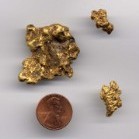
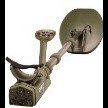
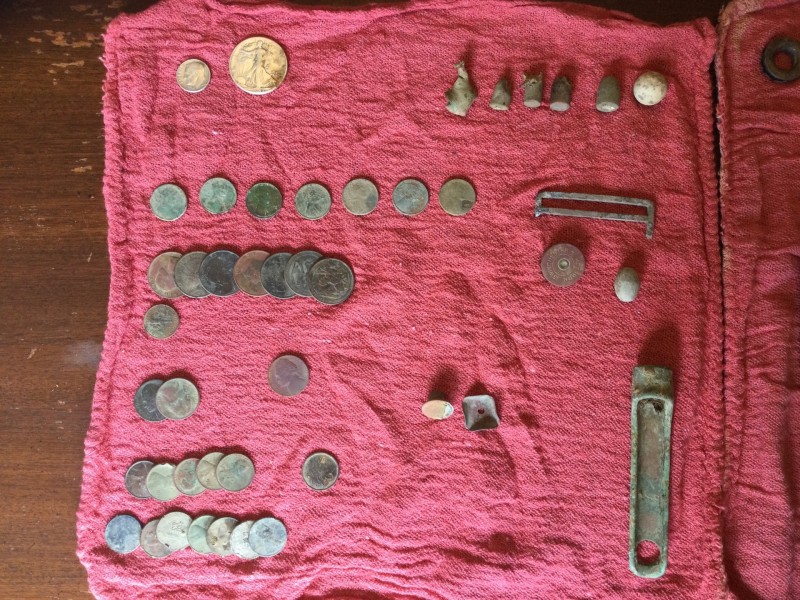
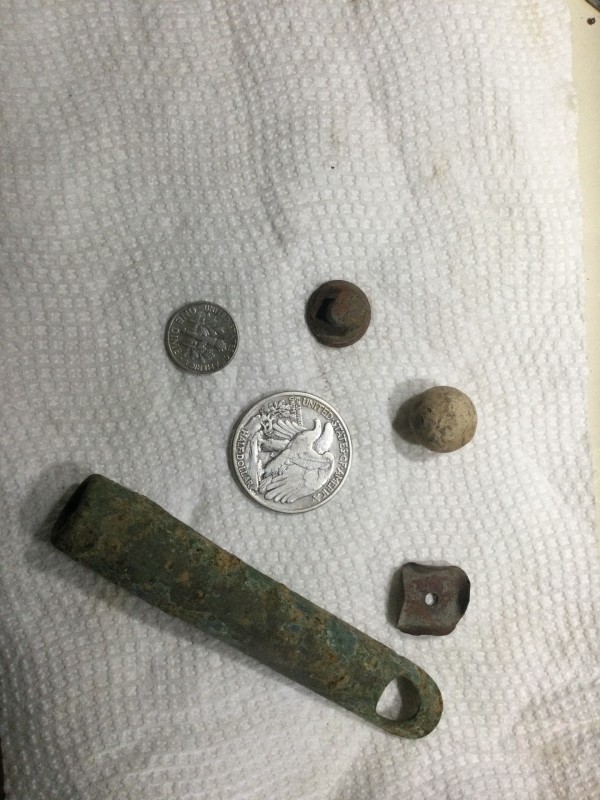
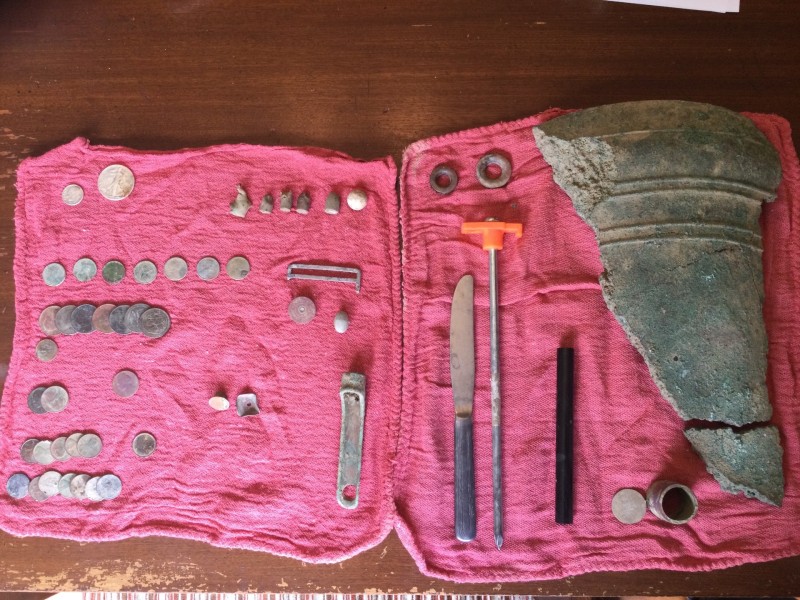
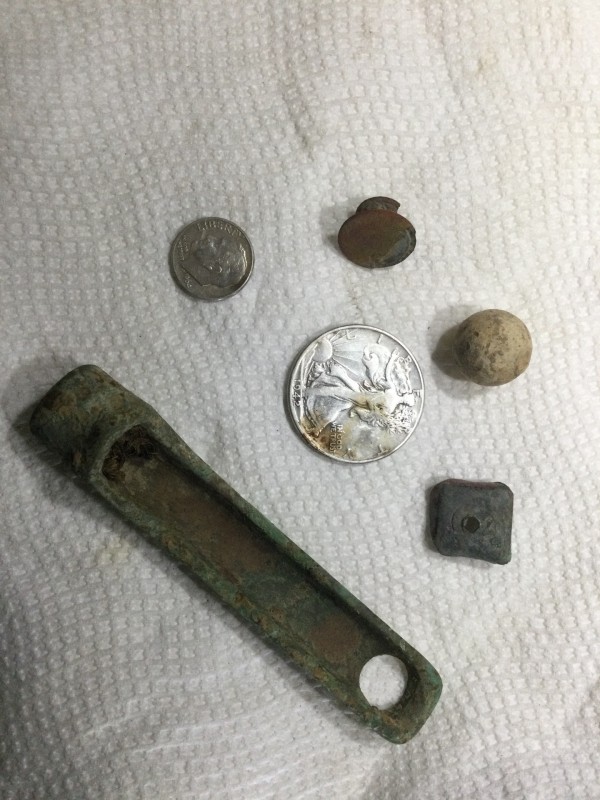





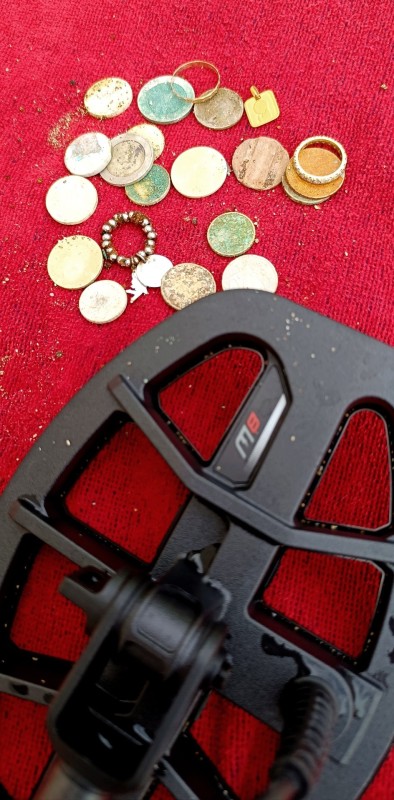
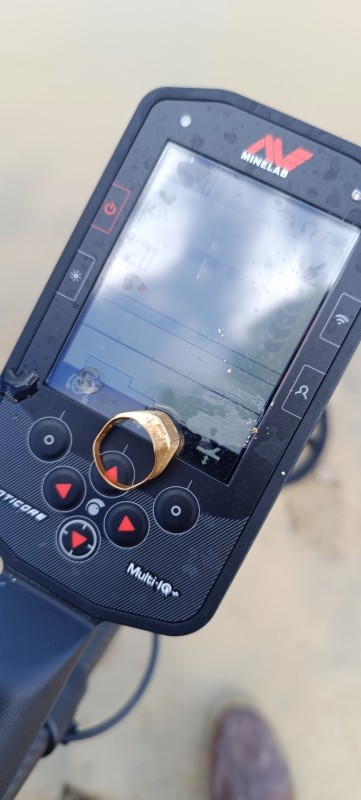

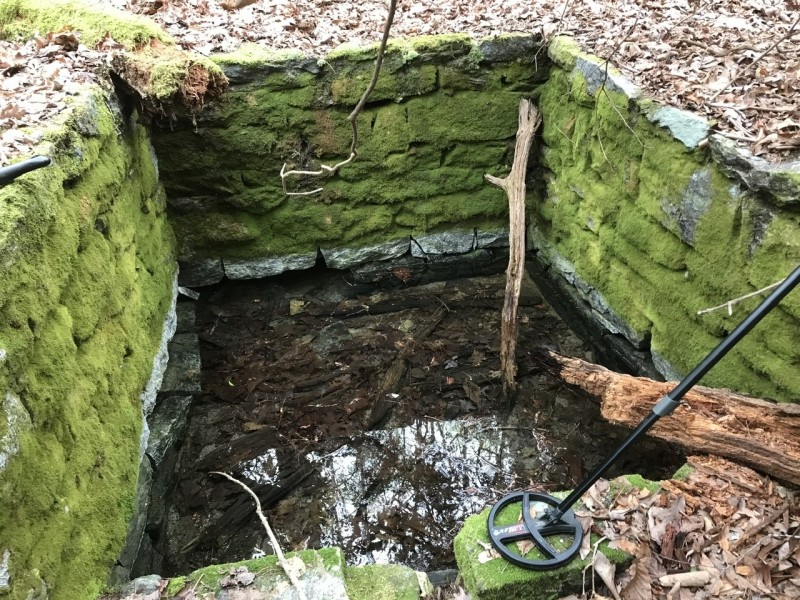
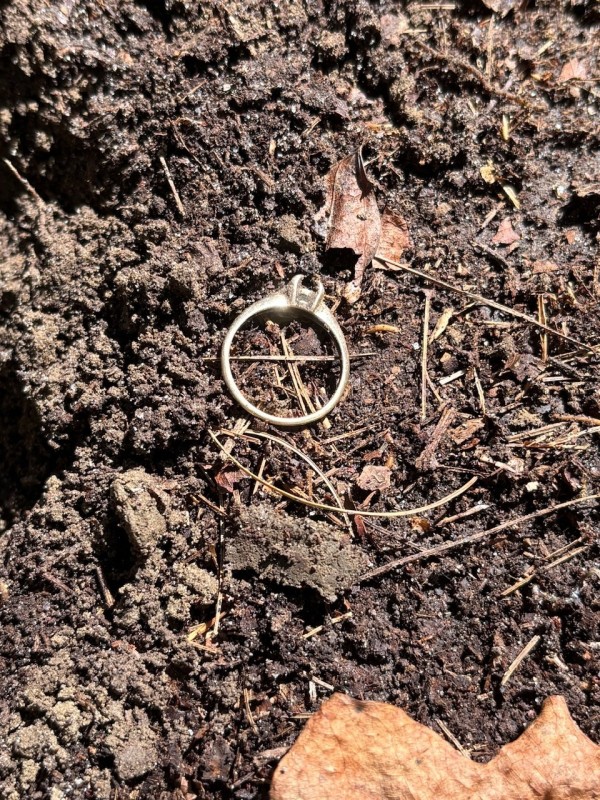
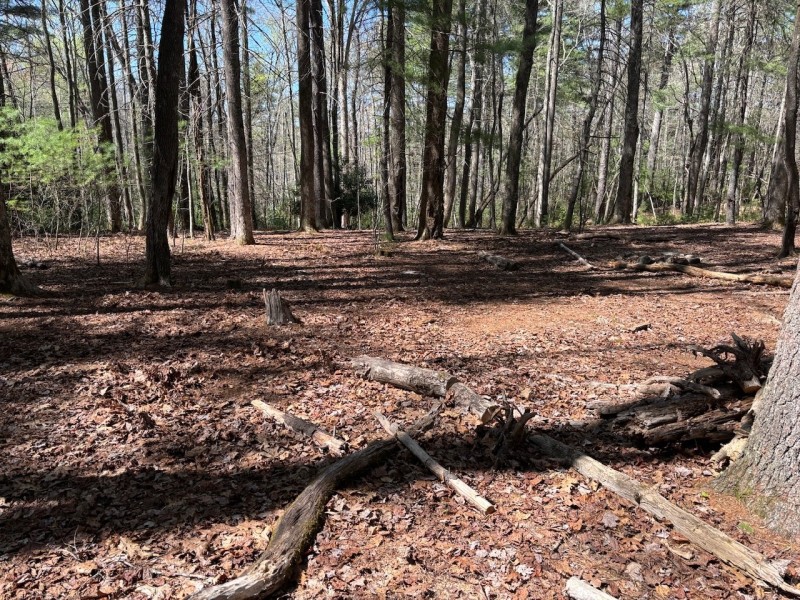
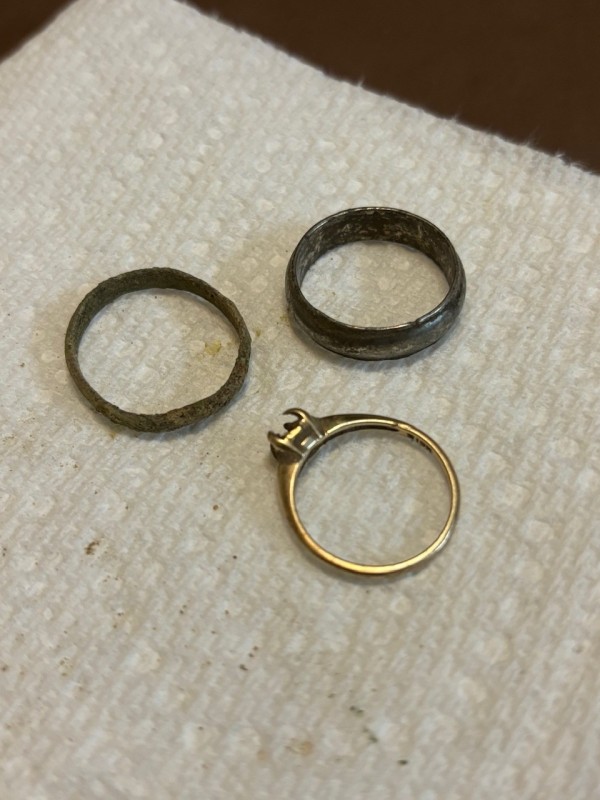

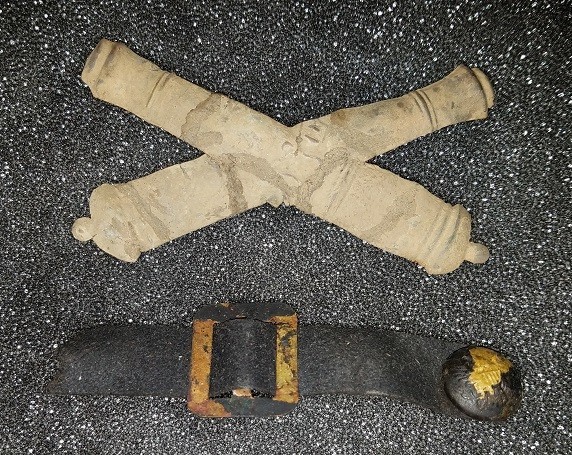


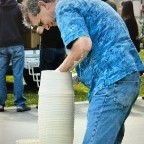

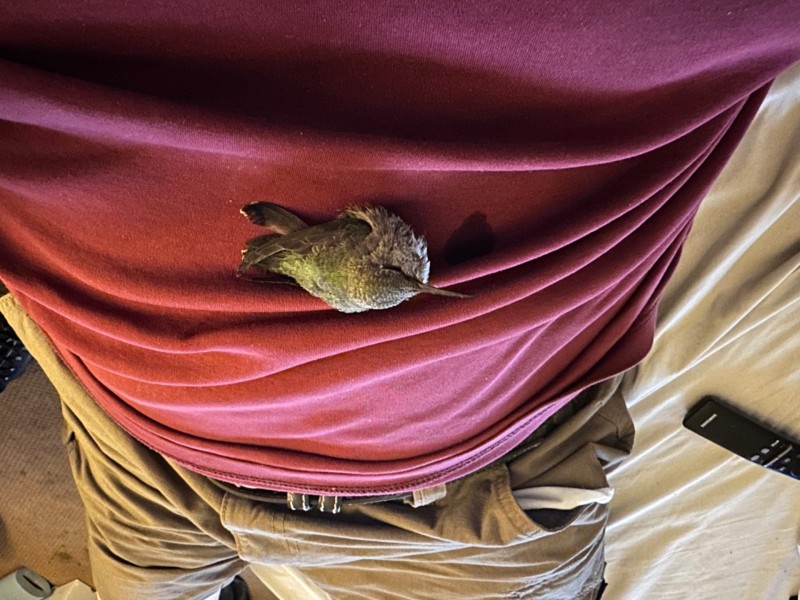
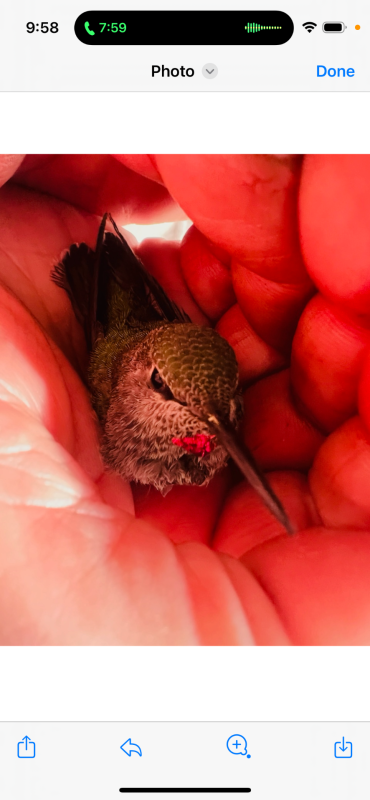



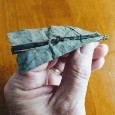

.thumb.jpg.8761b3d9b3da119b9e6d1912f67275ad.jpg)




